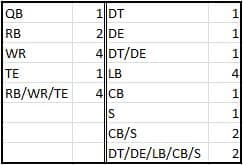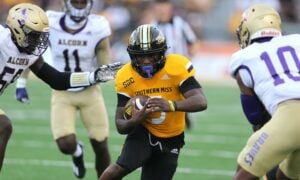Keeping Dynasty Weird: The Bull Horn Part Two
Part one of this mini-series explained what The Bull Horn is. If you haven’t read it, check it out, otherwise none of this will make any sense to you. This time around I am going to focus on the startup auction, which you can view here.
This league has 65 player rosters with unlimited space for devys on the taxi squad. For the startup auction, 48 devy picks were available to be bid on with a $1000 total budget per team. This means this auction was 828 total selections. Thanks to a group of very dedicated and knowledgeable owners, the startup only took 22 days to complete. To start the auction, each owner nominated three players per day. We bumped it up to four nominations after eight days and unlimited for the last several days.
As you can imagine, with such deep rosters and so many devy picks available there were varied strategies. To get a grasp of what teams needed to accomplish, have a look at the 25 player starting requirements.
[am4show have=’g1;’ guest_error=’sub_message’ user_error=’sub_message’ ]

I had four main goals I wanted to accomplish in this draft: stick to a loose budget, take advantage of good values when they made themselves available, acquire as many devy picks as I could, and zig when other owners zagged.
Budget and Values
When I said I had a loose budget, I really meant it. I did not assign dollar values to any specific players or devy picks, but I did assign dollar amounts for each starting position, the total I wanted to spend on devy picks, and the amount of money I wanted to spend on my bench players. This didn’t all go exactly to plan, but it did make for a team that I believe has the best depth in the league. I knew depth would be integral to having success in a league with such harsh starting requirements, so this design worked well for me.

There were some issues with my strategy, though. My most expensive player, Demaryius Thomas, equaled essentially a third round pick. There were 30 other players who were more expensive. However, 18 of those players were fellow wide receivers, so I actually feel I got a great deal on him. My second most expensive player, Eric Decker, saw 54 players more expensive. Again, I think it was a good value due to 30 other receivers being more expensive.
One major advantage I enjoyed with this strategy is while others spent big bucks early, I sat back and watched my bankroll stay strong. After only a handful of days, some owners had spent over $600 of their budgets while I had spent virtually none. In a league without such a large starting lineup, this would have been very problematic, but it wasn’t nearly as much of a concern in this format.
As I got deals on some starting players; such as Matthew Stafford for $25, DeSean Jackson as my WR3 for $20, Carlos Dunlap for $39, and Sheldon Richardson as my defensive line flex for $3; I was able to splurge for depth elsewhere. For instance, I added Anthony Barr, Leonard Floyd, and Shaq Lawson as my LB5-7 for $30. I have four solid starters and a few other bench linebackers who can start ahead of these younger guys while they develop. They essentially became free prospects for me while my older players play now.
I was also able to secure Morgan Burnett, Ha Ha Clinton-Dix, and Harrison Smith for a combined $49. This gives me three top tier safeties to use in my starting lineup for the same amount of money I was willing to spend on just one of them.
Devy Picks
Much to my surprise, I was able to win 16 devy picks in the auction for a total cost of $116. I went a little over budget due to all of the deals I had with my other players. This broke down to four second round picks, seven third round picks, and five fourth round picks. The closest I had to a premium pick was 2.03, but I packaged it with two later devy picks to secure the rights to Tajae Sharpe and a late fourth round devy pick.
My goal is to have as many darts to throw at possibly getting the next superstars as possible. While I would love to have won some earlier selections, I am happy to take this many shots at college players. This also gives me a bit of ammunition to move up and down the draft, should the opportunity arise. Since this will have been published after the completion of the devy draft, I can share my flexible strategy.
I plan on taking the best offensive players as possible who slip in the draft and then take some stabs at defensive players late. I’ve been advised to avoid defensive players, but I’ll take some stabs if I think a value presents itself. Specifically, I will look mostly at inside linebackers, interior linemen, and safeties who strongly project as NFL safeties or linebackers. Due to the changes in positions that many edge rushers see when moving to the NFL, I don’t want to risk taking them and seeing them lose value as outside linebackers in certain defensive schemes. Corner back won’t be on my radar due to how incredibly difficult I think they are to project.
Zigging When Others Zagged
The main way I felt I would be able to build a strong team from top to bottom was by not getting caught up in some of the spending sprees with other owners. There were vastly different strategies producing vastly different types of rosters.
One owner spent $366 on Randall Cobb, Amari Cooper, Mike Evans, and Julio Jones. He also won devy picks 1.02 through 1.05 for $156. Remarkably, he was able to capitalize on great young talent and stock up on devy picks for future growth. Now, I don’t love the entirety of his roster, but he’s going to be difficult to compete against if those picks become good players.
Another owner spent $175 on Navorro Bowman, D’Qwell Jackson, and Telvin Smith. He boasts one of the more powerful groups of starting linebackers in the league. This same owner, along with three others, decided not to invest in the devy draft at all, electing to build stronger lineups now.
In a move I still haven’t figured out, one owner took Tom Brady, Andrew Luck, Carson Palmer, and Jameis Winston for $267. This isn’t a strategy I personally would employ, but this is a points only league. If one of the owners who chose to go light on quarterbacks finds he is in need of a little late season push, this could be the owner with the solution.
One owner spent $239 on Le’Veon Bell, Carlos Hyde, Eddie Lacy and Thomas Rawls. Several of the owners went with a very balanced approach. One owner went heavy after his starting lineup and filled out a good portion of his bench with $1 players.
As you can see, there were many different approaches, and there’s no way of knowing which one will really pay off for quite some time. Just like in any other dynasty league, youth vs. veterans was a factor and in a much more exaggerated way. It’s become a very exciting league, and the season has yet to begin.
With these last keystrokes, the devy draft is in full swing. I’ll talk about that in the final instalment of this miniseries. It’s been a doozy of a draft so far, and even the back end of the draft has been full of excitement and trade talk.
[/am4show]
- Summer Sleeper: Buffalo Bills - September 5, 2017
- Summer Sleeper: Miami Dolphins - August 14, 2017
- How Broken Is Running Back Scoring? - July 9, 2017


































































